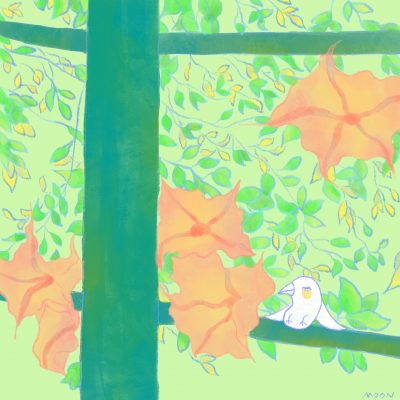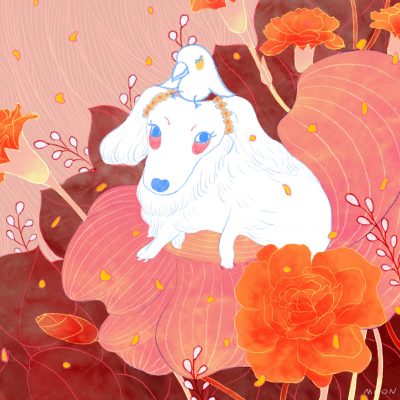An Interview with AICAD Post Graduate Teaching Fellow: Moon Wang

Yuezhu Moon Wang
Moon Wang is an illustrator and animation artist currently teaching at the Otis College of Art and Design in Los Angeles, California. After receiving her MFA from the California Institute of the Arts in 2022, she was placed with Otis College through the AICAD Post-Graduate Teaching Fellowship, where she is sharing her invaluable skills with students, teaching courses in illustration and animation techniques. We had the pleasure of catching up with Moon and inquiring about her trajectory as an AICAD fellow, teaching experience, and life as a working artist in an interview:
Joanna Booth (AICAD): Nice to meet you, Moon! Tell us about yourself! What brought you to the arts / your specific master’s program?
Moon Wang: Hello! I’m an international student from China. At first I studied architecture at a science and engineering university back in China. However, I wasn’t really into mathematics and physics in architecture at that time, I only enjoyed the part where I could draw and imagine what the building structure would look like. After finishing my undergraduate study, I began to seriously think about a future direction. I have liked watching cartoons and animation films since I was a child, so I thought animation might be a good idea (laughing). Then I decided to apply for the experimental animation graduate program at CalArts.
JB: What was the most compelling factor about the AICAD fellowship that prompted you to apply? What sparked your interest in teaching?
MW: I think the most compelling thing is that AICAD provides a platform for female minorities, which surprised and delighted me a lot! I never thought that as an Asian student, I would also have such a valuable chance to be a teacher after graduation, so I applied immediately!
My dad used to be a teacher, so I guess my love of teaching was influenced by him from an early age. I have been participating in part-time teaching or volunteering activities since I was in college. Every time I take classes with students, I can learn a lot from them and make friends. I think the happiness brought by my students is the reason that encourages me to be a teacher all the time.

Diary of the Little White Bird- I Like Spring, Moon Wang
JB: Can you tell us about your day to day routine as a fellow? What classes are you teaching and how do you engage with your students?
MW: Right now, I’m teaching junior and senior students illustration and animation techniques at Otis College of Art and Design. I have three classes each week this semester, and I attend faculty meetings once a month.
At first I was a little nervous and didn’t know how I would get along with the students, but with the help and guidance of other teachers, I gradually got used to each class. I think creating a chill atmosphere is a helpful way to start the class. For example, I like to share some animation videos that I like before teaching. Then students watch them and have discussions together. In this way, students can usually relax from the previous class and then delve into their studies. I also enjoy listening to them so that I can understand them better.
JB: How has teaching and experience with your students influenced your art practice?
MW: Yes, my students have definitely influenced me a lot! For example, I was teaching video editing skills in AfterEffects, and one of the students asked me more questions about motion curves, how to improve efficiency, etc. These questions helped me find better solutions, which I sometimes use when I do animation myself.
JB: Part of the fellowship is working at an institution that you didn’t attend. How has it been adjusting to a different academic environment and culture as an educator as opposed to a student? Has it changed your thinking or how you approach your own practice?
MW: Teaching classes at Otis was like entering a new school in the beginning. After all, I didn’t know any teachers or students, and I was not familiar with most departments of the school, so I was more or less a little nervous. As time went by, I found that everyone was willing to help me, so the uncomfortable feeling soon disappeared. When I was a student, I felt that the teacher would teach me everything, so I didn’t need to take the initiative to ask. But now working at Otis as a teacher, students will come to me for help, so I have to learn more new things, such as how to operate paper cutters, printers and so on. I also gained a deeper understanding of other students’ work and culture than before. They brought me a lot of inspiration about race, ethnic characteristics, traditional culture and so on. I now feel that art is more of a spontaneous exploration. The students’ questions and the help of other teachers have prompted me to think more about skills and diversity.

Diary of the Little White Bird – My Good Friend, Moon Wang
JB: What is it like balancing an art career and a teaching practice? Do you have any advice for other prospective fellows or educators of the arts?
MW: I’m actually still learning how to balance my art career and teaching life. Because every time I prepare for class content, it takes up a lot of my time. I’m also very tired after class. But I’m starting to work out now, hoping to have more energy to do more things. (Laughing) I guess this is my suggestion, everyone, don’t forget to exercise and protect your body!
You can find out more about Moon Wang’s art on Instagram at @moon_wyz or their website found here.